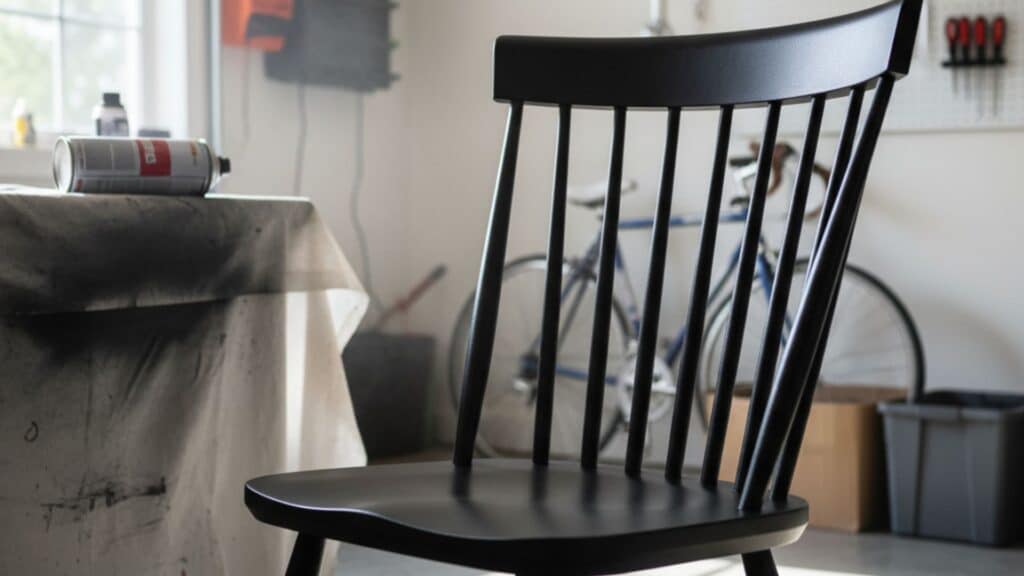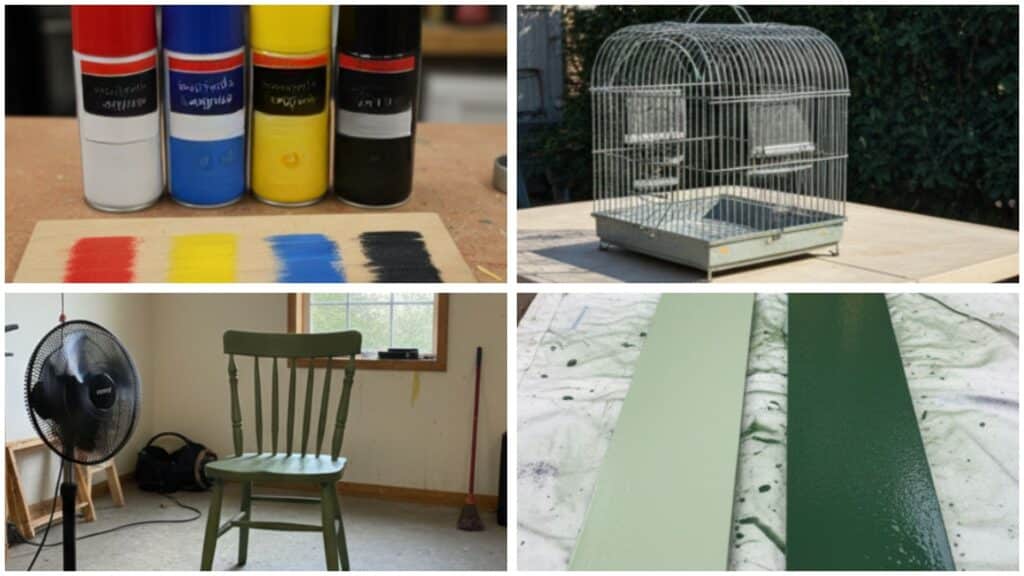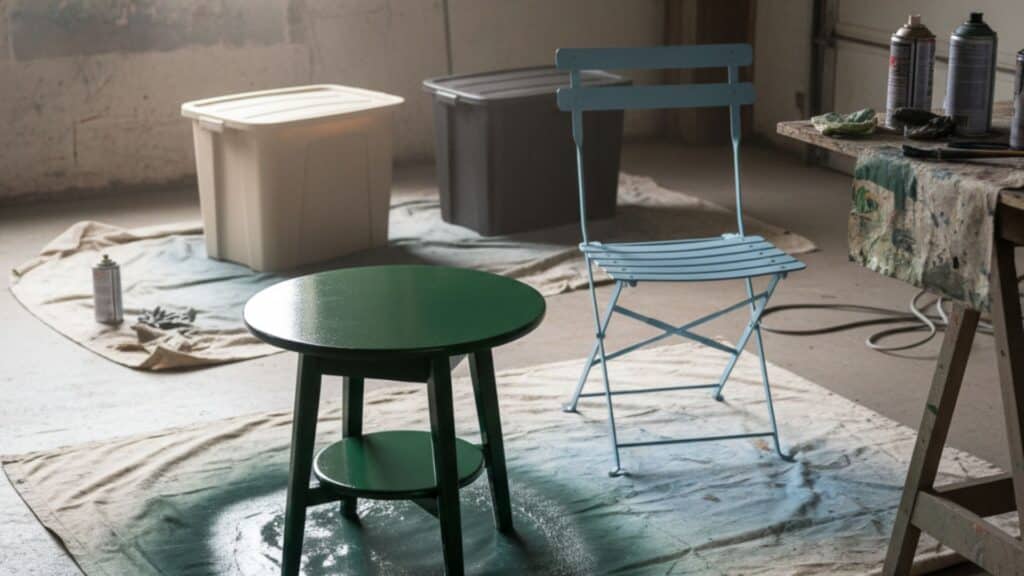Ever found yourself standing over a freshly spray-painted project, wondering when it’s safe to touch? I’ve been there too, and getting the timing right can be tricky for both beginners and experienced painters.
The question of how long it takes for spray paint to dry arises on every single project I see. Different surfaces, weather conditions, and paint types all change drying times in surprising ways that catch people off guard.
Temperature and humidity play huge roles that most people don’t expect when starting their first spray paint project.
You’ll learn exactly when to move, handle, and use your painted items with complete confidence and perfect results every time you paint.
Why Drying Time Makes a Difference with Spray Paint
Spray paint can seem quick and easy, but knowing the drying time is crucial for the success of your project. If paint stays wet too long, it can smudge or leave marks, ruining your work.
On the other hand, rushing to add a new coat before the last dries causes bubbling and peeling, which looks bad and weakens the finish.
Dry paint feels solid and smooth when fully dry to the touch. Waiting the right amount of time ensures a neat and long-lasting finish.
Patience helps you avoid costly mistakes and makes your spray paint job look professional and beautiful every time.
What is the Average Spray Paint Drying Time?

Spray paint drying times vary, but generally follow a simple pattern. Most spray paint becomes touch-dry in about 20 to 30 minutes.
This means you can lightly touch the surface without paint sticking to your fingers. However, becoming hard dry takes longer, often between 1 and 2 hours.
Hard dry means the paint is firm enough not to be easily damaged. The full curing process, during which the paint reaches its maximum strength and durability, typically takes 24 to 48 hours.
This full cure makes the paint more resistant to water, heat, and wear. Knowing these stages helps you plan the right wait before handling or recoating your painted item.
Stages of Spray Paint Drying
Understanding spray paint drying stages helps you get professional results every time. Each stage has different rules for what you can and can’t do with your painted item. Here’s what happens during each drying stage:
| Stage Name | Surface Feel | Durability Level | Usage Guidelines |
|---|---|---|---|
| Dry to the Touch | No wet or tacky feeling when lightly touched | Paint film has formed, but remains highly vulnerable to damage | Avoid any handling or contact. Surface looks dry, but the coating is still developing |
| Hard Dry | Surface feels firm and can withstand light contact | Stable enough for careful handling but soft under firm pressure | Safe for gentle repositioning and light use. Avoid stacking or applying heavy pressure |
| Fully Cured | Maximum hardness achieved with complete resistance to indentation | Full chemical bonding completed with optimal scratch and impact resistance | Ready for heavy-duty use, stacking, and exposure to harsh conditions. Final color and sheen stabilized |
Remember that rushing through these stages can ruin your paint job completely. Always wait for full curing before putting your painted items to heavy use.
Factors That Affect How Long Spray Paint Takes to Dry

I’ve learned that several things control how fast your spray paint dries. Understanding these factors helps me plan my painting projects better and avoid mistakes:
1. Paint Type
Different paint types dry at completely different speeds. Acrylic paints dry fastest, usually within 30 minutes to the touch. Lacquer comes next and hardens quickly, but needs good ventilation.
Enamel takes longer but provides a super-tough finish. Oil-based paints are the slowest, sometimes taking hours just to feel dry. Each type has its own chemistry that affects drying time.
2. Temperature and Humidity
Hot, dry air makes paint dry much faster than cold, wet conditions. High humidity keeps moisture in the air and slows everything down.
Cold temperatures under 50 degrees can double your drying time. The sweet spot is around 70 degrees with low humidity. Avoid painting on rainy or very humid days if possible.
3. Airflow and Ventilation
Moving air carries away moisture and speeds up drying significantly. A simple fan can easily cut drying time in half. Good ventilation also keeps fumes from building up around your project.
Still air creates a moisture bubble that slows the process. Open windows or doors to help fresh air circulate through your workspace.
4. Thickness of Coat
Thick coats take much longer to dry than thin, even layers. Heavy application traps moisture underneath and causes problems later. Multiple thin coats are often more effective than a single thick coat.
You get smoother results and faster drying between applications. Thick paint can stay soft for hours longer than expected.
How Long Does Spray Paint Take to Dry on Different Surfaces?
Different surfaces affect how your spray paint behaves and dries. Some materials help paint dry faster, while others slow things down:
| Surface | Drying Characteristics | Typical Dry Time | Special Considerations |
|---|---|---|---|
| Wood | Absorbs paint into fibers, creating slower surface drying | 30-60 minutes to touch | Unsealed wood soaks up paint and may need primer first |
| Metal | A non-porous surface allows faster drying with thin coats | 15-30 minutes to touch | Clean, rust-free metal gives the best results and fastest drying |
| Plastic | Poor paint adhesion creates drying and bonding challenges | 45-90 minutes to touch | May need special plastic primer for proper adhesion |
| Cardboard | Absorbs paint quickly, but there is a material risk of warping from moisture | 10-20 minutes to touch | Use light coats to prevent warping or soggy cardboard |
| Rubber | Dense, flexible surface causes very slow drying, may stay tacky | 2-4 hours to touch | Often remains slightly soft even when dry to the touch |
Research shows that wood’s porous structure can increase spray paint drying time by 40% compared to non-porous surfaces. Knowing how long spray paint takes to dry on wood prevents premature handling.
Common Reasons Spray Paint Isn’t Drying
Nothing’s more frustrating than spray paint that won’t dry properly. Here are the most common culprits behind sticky, wet paint:
- Indoor vs. outdoor conditions change drying time: Outdoor airflow speeds drying, but weather risks like wind, dust, and moisture can ruin fresh paint.
- Cold or damp conditions: Temperatures below 50°F or high humidity slow down the chemical drying process significantly.
- Using the wrong paint type for the surface: Some paints just don’t bond well with certain materials like plastic or rubber.
- Poor ventilation: Still air creates a moisture bubble around your project that keeps paint wet longer.
Fix these issues, and your paint will dry much faster next time. Most drying problems come down to rushing the process or ignoring environmental conditions.
How Long to Wait Before…

I’m often asked about timing when it comes to spray paint projects. Knowing when it’s safe to move to the next step saves me from ruining hours of work:
Action 1: Adding a Second Coat
Wait: Wait at least 15 to 30 minutes between spray paint coats for best results. Applying the next coat too soon can cause the paint to run or become uneven.
Action 2: Moving or Handling Items
Wait: Let the spray paint dry for 1 to 2 hours before carefully moving your painted items. Light handling is acceptable after this time, but avoid applying pressure to the surface.
Action 3: Exposing to Rain or Outdoor Conditions
Wait: Wait a full 24 hours before exposing spray-painted items to rain or harsh weather. Moisture can ruin paint that hasn’t fully cured, causing permanent damage to your finish.
Action 4: Using Furniture or Painted Surfaces Regularly
Wait: Allow 48 to 72 hours before using painted furniture or surfaces for heavy daily use. This gives the paint time to reach maximum hardness and resist scratches or dents.
Tips to Make Spray Paint Dry Faster
Sometimes you need your paint to dry quickly for your project timeline. Here are proven ways to speed up the drying process:
- Apply thin, even coats. Multiple light layers dry faster than one thick coat and give smoother results.
- Improve airflow with fans or open windows. Moving air carries away moisture and cuts drying time in half.
- Use heat carefully with a hair dryer or a heat gun. Gentle warmth speeds drying but too much heat can bubble the paint.
- Choose fast-dry spray paint formulas. Special quick-dry paints are made to harden in minutes instead of hours.
These simple tricks can save you hours of waiting time. Just remember that rushing too much can still ruin your finish quality.
Final Words
Getting spray paint timing right takes practice, but the results are absolutely worth the patience and effort involved.
I hope these tips help you tackle your next spray paint project with complete confidence and lasting success.
Remember, every surface behaves differently. Each paint type has its own unique schedule, so plan your projects accordingly for the best possible results.
Temperature, humidity, and ventilation all play huge roles in achieving that perfect finish you’re after. Your projects will look much better and last significantly longer when you follow proven timing methods.
Do you have questions about your specific spray paint project? Drop a comment below and let’s work together to solve it!














